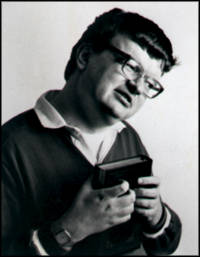
Photo from wikipedia
Portrayals of autism spectrum disorder in film, television and literature often show special or “savant” skills: a young child who can crack advanced codes, an adult with astonishing memory, or… Click to show full abstract
Portrayals of autism spectrum disorder in film, television and literature often show special or “savant” skills: a young child who can crack advanced codes, an adult with astonishing memory, or a musician who can play any tune by ear after a single hearing. Are such portrayals realistic or helpful? Special abilities are more common in autism than in other groups, with one study finding that a third of autistic adults showed superior skills in one or more areas by parental report and on psychometric tests. Some well-documented skills are as astounding as any in fiction, such as the renowned artist S. Wiltshire’s ability to draw in beautiful detail the cityscape of Tokyo from memory after a single 20 min helicopter ride over the city. Special skills typically fall into a narrow range of areas. A recent study suggested that more than 70% of autistic children and adults had a special isolated skill in memory (52% of the sample), visuo-spatial abilities (32%), calculation, drawing or music (about 17% for each area). Parents are often understandably annoyed by the emphasis on savant skills in the media: “When neighbours ask me what my autistic son’s special talent is, I tell them it’s having a meltdown in the store because the fluorescent lights flicker!”, one mother told me. On the other hand, identifying and fostering special interests and abilities can increase self-esteem, opportunities for interaction and appreciation, and employment options for those on the autism spectrum. What can the study of special skills tell us about autism, and what can their raised incidence in this group teach us about the nature of extreme talents more generally? My first autism research experience was assessing memory skills in mnemonists for N. O’Connor and B. Hermelin, the pioneers of cognitive research in autism, who first demonstrated that no child was ineducable or untestable. Their student and colleague U. Frith continued this tradition, showing that more could be learnt about autism through exploration of assets than of deficits. Her “weak central coherence” theory was built on demonstrations of superior jigsaw-puzzle-like disembedding skills in autism. This “eye for detail” – the tendency to process local rather than global information – may be an important starting engine for talent. In a study of more than 6,000 8-year-old twins, parent-reported talents in music, maths, art or memory were positively associated with parent-reported autistic-like traits, and specifically with rigid and repetitive interest and activities. Children reported to have special talents were said to show more autistic traits, and in particular to notice and remember details that others miss. Twin modelling (comparing monozygotic and dizygotic cross-twin cross-trait correlations) suggested largely overlapping genetic effects on these two variables: much of the genetic influence on talents was also affecting individual differences in autistic-like rigid/repetitive and eye for detail traits. That – crudely put – genes “for” talent overlap with genes “for” autism fits with recent evidence suggesting that common alleles associated with autism have been positively selected for during human evolution, and correlate with childhood intelligence and educational attainment in the general population. Detail-focused processing may lie at the root of autistic musical and artistic talent. All musical savants tested to date have shown absolute pitch, but autistic children even without musical training or proficiency are much better able than neurotypical children to hold exact pitch information in mind over days and weeks. While in typical development children move from focus on exact notes to tunes (which can be recognized across different transcriptions), in autism the ability to maintain exact representations appears to be preserved. One multiply talented autistic man could not only name musical tones but also identify the pitch of spoken words or environmental sounds. Many autistic artists have a beautifully detailed style, and some draw from part to neighbouring part rather than sketching the outline first. Eye for detail, and a relative preference for local versus global processing, is characteristic of autism, but can of course be found in neurotypical people. The different cognitive facets of autism appear to “fractionate”, with different underlying genetic and neural underpinnings. This means that highly talented people may share a cognitive style with autism, but may not share the socio-communicative difficulties. Eye for detail is part of the cognitive phenotype of autism, but does not explain everything. Autistic social and communication difficulties appear to result from impaired “theory of mind”: while neurotypical children spontaneously and unconsciously read others’ behaviour as evidence of invisible mental states (“she’s looking in the drawer because she wants something she thinks is in there”), autistic children and adults do not automatically do so. For them, “reading minds” is hard, conscious calculation – as exhausting as doing long division might be for neurotypicals. The absence of intuitive and even obligatory “mentalizing” in autism may also contribute to talent. People with autism may be less subject to herd thinking, andmore able to take original perspectives. Certainly, new evidence suggesting increased perceptual capacity (both visual and auditory) in autism provides a new avenue to understand and explore talent, and possible links to sensory hypersensitivity, distraction and aversion. Along with eye for detail and reduced mentalizing, autism is also characterized by executive dysfunction, most evident when having to deal with change and novelty. The autistic “insistence on sameness” may reflect difficulty in frontal lobebased executive skills such as planning ahead, monitoring, flexibly shifting set and inhibiting habitual responses. Could executive dysfunction also contribute to talent in autism? Repetition is certainly not the enemy of creativity, as evident in
Journal Title: World Psychiatry
Year Published: 2018
Link to full text (if available)
Share on Social Media: Sign Up to like & get
recommendations!